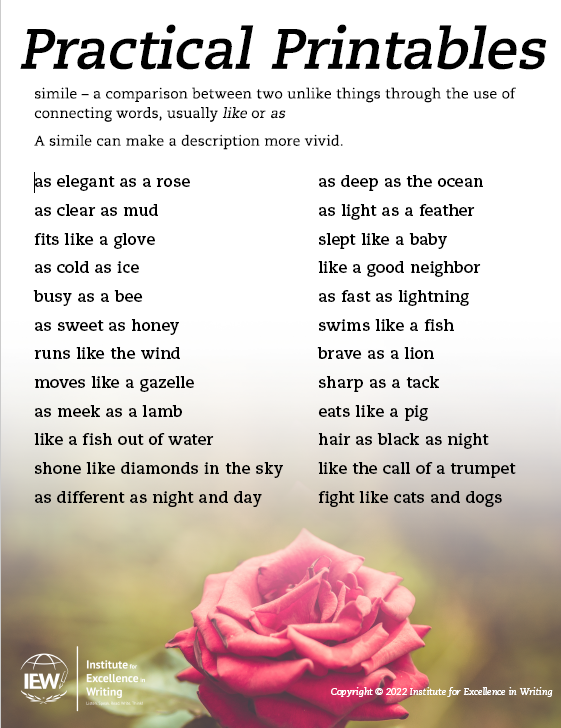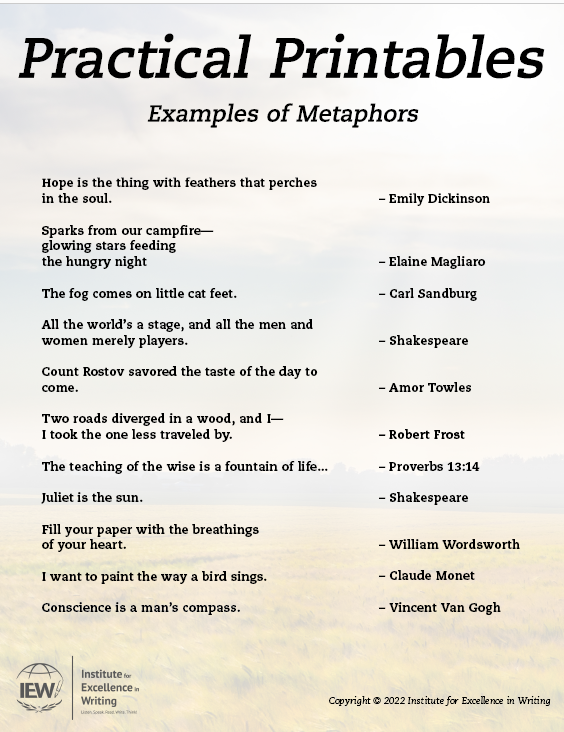As was mentioned in a previous post, in their writing toolbox, poets and authors have a plethora of tools that they can use to create word pictures in the minds of their readers. Our first post that examined one of these tools featured onomatopoeia. Two more literary devices are similes and metaphors. Both of these devices have similar functions: to draw comparisons between two unlike things. Keep reading to learn how similes and metaphors are similar and how they are different.
Simile shares the same Latin root as the word similar: similis, which means “similar” or “like.” Similes draw a comparison noting a likeness between two otherwise unlike things. A hallmark of a simile as opposed to a metaphor, which we will address further on in this blog post, is that it includes the words like or as. William Wordsworth’s Romantic poem “I Wandered Lonely as a Cloud” incorporates a simile right in the title, drawing a likeness between the words lonely and cloud. If you have ever said that you are “as busy as a bee” or “as hungry as a horse,” you have used a simile as well as a bit of alliteration. To discover more similes and to practice creating a few of your own, read through this Practical Printable.

Andrew Pudewa’s Linguistic Development through Poetry Memorization is filled with poetry that incorporates similes. Here is just one example, a poem composed by Alfred, Lord Tennyson:
The Eagle
by Alfred, Lord Tennyson
He clasps the crag with crooked hands;
Close to the sun in lonely lands,
Ring’d with the azure world, he stands.
The wrinkled sea beneath him crawls;
He watches from his mountain walls,
And like a thunderbolt he falls.
While a simile observes how two things are similar, a metaphor intensifies the comparison by making the two things (or ideas or actions) equivalent. The word metaphor is derived from the Greek word metaphora, which means “a transfer.” In this case it literally means one word transferring its meaning to another word.
In Level Two of Linguistic Development through Poetry Memorization, Joyce Kilmer’s poem “Trees” celebrates the creation of trees through several beautiful metaphors sprinkled throughout the verse. It is printed in full below:
Trees
by Joyce Kilmer
I think that I shall never see
A poem lovely as a tree.
A tree whose hungry mouth is prest
Against the earth’s sweet flowing breast;
A tree that looks at God all day,
And lifts her leafy arms to pray;
A tree that may in Summer wear
A nest of robins in her hair;
Upon whose bosom snow has lain;
Who intimately lives with rain.
Poems are made by fools like me,
But only God can make a tree.
Here a tree is described as a nursing infant as well as a worshipful woman who wears a nest of robins in her hair. The metaphors underscore the beauty and grace of divine creation: trees. Interestingly, the poem begins with a simile, comparing a poem to a tree. Ultimately the comparison falls short, and the ensuing stanzas explain why, with the final line, “But only God can make a tree.”
To read even more examples of metaphors used across literature and poetry, read through this Practical Printable.

Literature, plays, and poetry are replete with metaphors and similes. Their presence enriches the piece, making the words feel more dynamic and alive. To encounter more of these particular literary devices (and many others as well), take a look at Linguistic Development through Poetry Memorization. You can obtain a free sample of the first five poems in Level One by clicking on this link.
|
Jennifer Mauser has always loved reading and writing and received a B.A. in English from the University of Kansas in 1991. Once she and her husband had children, they decided to homeschool, and she put all her training to use in the home. In addition to homeschooling her children, Jennifer teaches IEW classes out of her home, coaches budding writers via email, and tutors students who struggle with dyslexia. |


